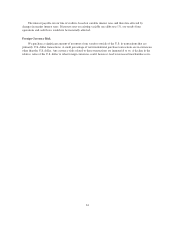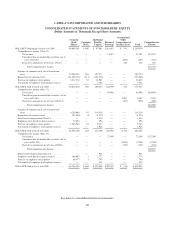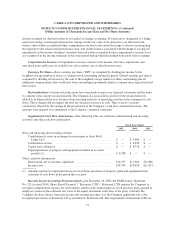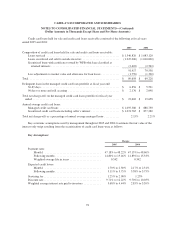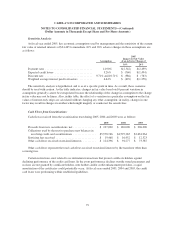Cabela's 2005 Annual Report Download - page 81
Download and view the complete annual report
Please find page 81 of the 2005 Cabela's annual report below. You can navigate through the pages in the report by either clicking on the pages listed below, or by using the keyword search tool below to find specific information within the annual report.CABELA’S INCORPORATED AND SUBSIDIARIES
NOTES TO CONSOLIDATED FINANCIAL STATEMENTS—(Continued)
(Dollar Amounts in Thousands Except Share and Per Share Amounts)
24th day of the month after an account becomes 115 days contractually past due, except in the case of cardholder
bankruptcies, cardholder deaths and fraudulent transactions, which are charged off earlier. Interest income is
accrued on accounts that carry a balance from the statement date through the end of the month.
Cost of Revenue and SG&A Expenses—The Company’s consolidated cost of revenue primarily consists of
merchandise acquisition costs, including freight-in costs, as well as shipping costs. The Company’s consolidated
SG&A expenses primarily consist of selling expense, marketing expenses, including amortization of deferred
catalog costs, warehousing, returned merchandise processing costs, retail occupancy costs, costs of operating our
bank, depreciation, amortization and general and administrative expenses.
Land Held for Sale or Development—The Company owns a fully consolidated subsidiary, whose primary
activity is real estate development. Land that is purchased and held for sale is shown in other assets. Proceeds
from sale of land are recorded in other revenue and the corresponding cost of the land sold is recorded in cost of
revenue.
Cash and Cash Equivalents—Cash equivalents consist of commercial paper and other investments that are
readily convertible into cash and have maturities at date of purchase of three months or less. Unpresented checks
net of bank balance in a single bank account are classified as current liabilities. WFB had $80,569 and $58,147 of
cash and cash equivalents in fiscal years 2005 and 2004, respectively. Due to regulatory restrictions the Company
is restricted from using this cash for non-banking operations, including for working capital for the direct and
retail businesses.
Securitization of Credit Card Loans—WFB sells a substantial portion of its credit card loans. Thus a
majority of the credit card loans are classified as held for sale and are carried at the lower of cost or market. Net
unrealized losses, if any, are recognized through a valuation allowance by charges to income. Although WFB
continues to service the underlying credit card accounts and maintains the customer relationships, these
transactions are treated as sales and the securitized loans are removed from the consolidated balance sheet. WFB
retains certain interests in the loans, including interest-only strips, cash reserve accounts and servicing rights.
Under Statement of Financial Accounting Standards (“SFAS”) No. 140, Accounting for Transfers and
Servicing of Financial Assets and Extinguishments of Liabilities, gains or losses are recognized at the time of
each sale. These gains or losses on sales depend in part on the carrying amount assigned to the loans sold, which
is allocated between the assets sold and retained interest based on their relative fair values at the date of transfer.
For the fiscal years ended 2005, 2004 and 2003, WFB recognized gains on sale of $17,020, $8,864 and $5,894,
respectively, which are reflected as a component of Financial Services revenue.
Since WFB receives adequate compensation relative to current market servicing rates, a servicing asset or
liability is not recognized.
For interest-only strips, WFB uses its best estimates for fair values based on the present value of future
expected cash flows using assumptions for credit losses, payment rates and discount rates commensurate with the
risks involved. The future expected cash flows do not include interchange income since interchange income is
only earned when and if a charge is made to a customer’s account. However, WFB has the rights to the
remaining cash flows (including interchange fees, if any) after the other costs of the trust are paid. Consequently,
interchange income on securitized loans is included within securitization income of Financial Services revenue.
Financial Services revenue is presented in Note 20.
69




